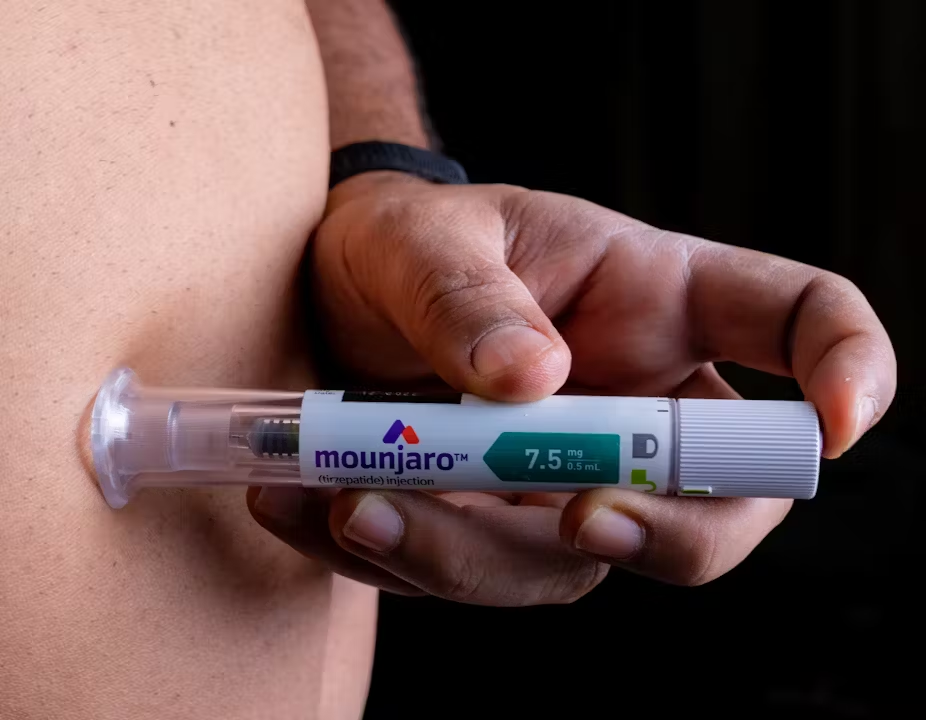1. Obesity: A Health Crisis in America
According to the CDC, more than 42% of adults in the United States are obese, with nearly 9% of them classified as severely obese (BMI 40 or higher). This is not just a matter of appearance or lifestyle, but a chronic condition, directly related to the risk of cardiovascular disease, type 2 diabetes, stroke, cancer and premature death.
Since 2021, with the FDA approval of GLP‑1 drugs such as Wegovy, Saxenda, and later Mounjaro (Tirzepatide), the medical community has had a powerful new tool in the treatment of obesity. These drugs not only effectively promote weight loss but also improve many biomarkers related to metabolism.
2. What is GLP‑1 injection and how does it work?
GLP‑1 receptor agonists are a class of drugs that mimic natural hormones in the gut and work to slow digestion, increase feelings of fullness, reduce hunger, and control blood sugar levels. Some common types include:
-
Semaglutide: Trade names Wegovy (for weight loss) and Ozempic (for diabetes)
-
Liraglutide: Saxenda (weight loss) and Victoza (diabetes)
-
Tirzepatide: Mounjaro (currently used for diabetes, expanding to weight loss indication)
Large clinical trials have shown average weight loss of 10% to 20% of body weight after 12–15 months of use.
3. Does Medicaid cover weight loss injections?
The answer is: it depends on the state. Medicaid is a federal program but is administered and implemented by state governments, so coverage for GLP‑1 drugs for weight loss is not uniform across the country.
By mid-2025:
-
Approximately 13 to 14 states including California, Massachusetts, Illinois, New York, Michigan and Minnesota have Medicaid that fully or largely covers weight loss medications for eligible patients.
-
About 20 states cover GLP‑1s only if the patient has a diagnosis of diabetes, not for pure obesity.
-
More than 14 states, including Texas, Georgia, and Mississippi, do not cover weight-loss drugs at all, regardless of BMI or underlying health conditions.
It is this division that causes people in different states to have completely unequal levels of access, creating serious health inequities.
4. Conditions for Medicaid approval of weight loss injections
In states that offer assistance, patients must adhere to strict requirements such as:
-
BMI of 30 or higher, or 27 if accompanied by at least one underlying medical condition (such as high blood pressure, type 2 diabetes, sleep apnea)
-
Have a history of failed treatment with lifestyle changes (diet – exercise)
-
Must have a formal treatment plan from a doctor, prescribed correctly
-
Some states require patients to participate in an intensive weight management program (behavioral therapy or dietary program) before being approved.
Additionally, most states require prior authorization – meaning the doctor and patient must submit a medical explanation and wait for Medicaid approval.
5. Documented medical benefits
Not only does it help you lose weight effectively, GLP‑1 injections also provide long-term benefits such as:
-
Reduce blood pressure and improve blood lipid index (LDL, triglyceride)
-
Improve insulin sensitivity, reduce the risk of progression to diabetes
-
Reduces systemic inflammation, contributing to a reduced risk of cardiovascular events
-
Enhance liver function, improve non-alcoholic fatty liver disease
-
Support mental health, improve quality of life
Many studies also show that maintaining drug use for 1-2 years can help reduce up to 15-20% of weight without seriously affecting internal organ function.
6. Side effects and important notes
GLP‑1 injections are not without risks. Some common side effects include:
-
Nausea, vomiting, diarrhea or constipation
-
Stomach ache, bloating, fatigue
-
Anorexia leads to nutritional deficiencies if not carefully monitored.
Serious but rare complications include:
-
Acute pancreatitis
-
Gallbladder disease
-
Acute kidney injury
-
Increased risk of medullary thyroid cancer (especially in people with family history)
Therefore, any medication plan should be carefully evaluated by a medical professional.
7. Biggest barriers: cost and politics
While the drugs are effective, cost is a major barrier. The street price of these drugs ranges from $1,200 to $1,500 per month without insurance.
States are often concerned that the cost of GLP‑1 therapy will put too much strain on Medicaid budgets, especially when millions of people are eligible. That’s why many states have yet to expand coverage—despite studies showing that treating obesity early can reduce chronic health care costs later.
Additionally, in 2025, the federal government through the Centers for Medicare & Medicaid Services (CMS) declined to expand GLP‑1 coverage for weight loss nationwide, further delaying any reform.
8. Instructions for patients who want to start treatment
If you have Medicaid coverage and want to know if you can access weight loss injections, follow these steps:
-
Make an appointment with a specialist for a comprehensive assessment of your BMI and underlying medical conditions.
-
Prepare documents to prove that you have tried to lose weight through diet and exercise but were unsuccessful.
-
Ask your doctor about the list of drugs covered in your state.
-
Submit a request for prior authorization and wait for the results.
-
Once approved, begin treatment regimen with nutrition and physical activity counseling.
9. Conclusion
Injectable weight loss drugs have opened a new chapter in obesity treatment in the United States, bringing real hope to those who have failed with traditional methods. However, the reality is that only a small portion of the population can access this method through Medicaid – due to policy divisions, costs and complex procedures.
If you or a loved one is struggling with obesity, it is important to be proactive in understanding your state’s policies and working closely with your doctor to get timely assessment and support.


